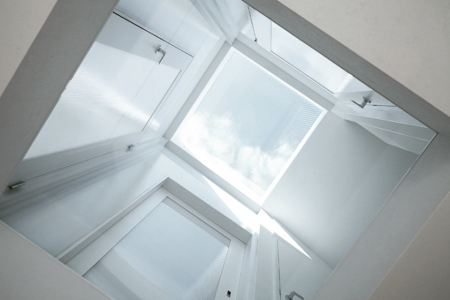形の無い事を表現
今はより小さな物に興味が向き、それは形のある物で、さらには、形の無い物、それはすでに物では無くて、人の気分や感情、関係性などにも興味が移り、それらの形の無い事が形のある物に対して、どのように影響を及ぼすかを考えていることが多い。
形の無い事、気分や感情、関係性などを建築で扱おうとすると、それ自体には形につながる情報が無いので、それ自体を直接的に形にすることは難しいから、形のある物との連続的なつながりとして扱うことによって、建築でも形として扱えるのではないかと考えている。
建築を説明する言葉として、形の無い事、気分や感情、関係性などを語ることは意外と簡単にできるが、やはり、建築として、形のある物として表現したい。
それはまだ、建築より小さな物、それ自体が動かせる物の方が表現しやすいかもしれない。簡単に言えば、取り替えることもできるし、形を容易に変えることもできるから、気分や感情を反映しやすい。建築は動かないし、形も容易には変えられないから、そのような反映の仕方は難しい。
それだけに、形の無い事、気分や感情、関係性などを建築として、形のある物として表現することには意味があると考えている。
ひとつは、動かず、形も変わらないけれど、「〜のように見える」と想えることかもしれないと、それは形を扱うことにつながるのではないかと考えていて、それを建築として、形のある物として表現しようとしている。
"Expressing intangible things"
Now I am interested in smaller things, which are tangible things, and even shapeless things, which are not already things, but also interest in people's moods, emotions, relationships, etc. I often think about how the absence of something has an effect on things with shape.
If you try to deal with things without form, moods, emotions, relationships, etc. in architecture, it is difficult to directly form itself because there is no information that leads to form itself. By treating it as a continuous connection, I think that it can be treated as a form in architecture.
It is surprisingly easy to describe things without form, moods, feelings, relationships, etc. as words to describe architecture, but I still want to express it as something with form as architecture.
It may still be easier to express things that are smaller than architecture and that can move themselves. Simply put, they can be replaced and easily reshaped, making it easier to reflect mood and emotions. Such a reflection is difficult because architecture does not move and its shape cannot be easily changed.
For that reason, I think it is meaningful to express things without form, moods, emotions, relationships, etc. as architecture and forms.
One is that it doesn't move and its shape doesn't change, but thinking that it may be "looks like" might lead to dealing with shape. Trying to express it as an object.

